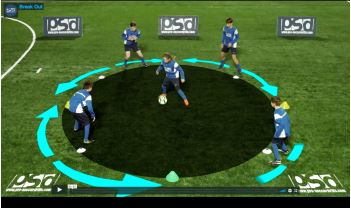Basics of the 3-5-2
Setup
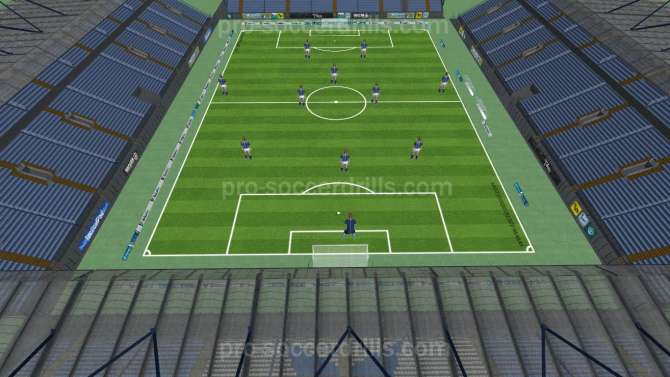
3-5-2 is a game system that can be seen during many games in and out of possession, but many teams do it unintentionally. So people don’t speak about it as much as they do about the 4-3-3 and 4-2-3-1. Systems with a back four often transform into a back three as players leave their position. Coaches and fans want balance in every team. This balance also exists in the 3-5-2 as there are more lines than three. There is a line for the three defenders, the defensive midfielders, the attacking midfielders, the wingers and for the attackers. If all lines are filled with players, it gives formational confidence and balance to the team.
When people say 3-5-2 formation, every one of them may think about another formation as there can be one or two defensive, one or two attacking midfielders and so on. So let’s go into details more and see the advantages and the disadvantages of these formations.
THE BACK THREE
The 3-5-2 always has 3 defenders in the back. 3 defenders are great and useful if the opponent is playing with two strikers as there are always a free, floating defender who can give cover and balance to the teammates. In this case, they play in between the two half-spaces on the pitch and take care of the two strikers. This doesn’t mean this formation and system can’t be played effectively against an opponent with one striker but coaches should give other instructions to the players. When there is one striker only, coaches can make their back three transform into two centre backs and a defensive midfielder by pushing up someone.
In possession against one striker, coaches should make the defenders split and play wide to be able to circulate the ball without any risk. By making them go towards the flank zones, wing players should go in a more advanced position next to the sideline. By this, the opponent steps back and there is more space for the defenders to change the point of the attacks. This back three is quite safe in case of losing the ball. This split also give more space to the centre midfielders but it’s true that one more player is pulled back from there, so the ball possession might change into an inactive possession.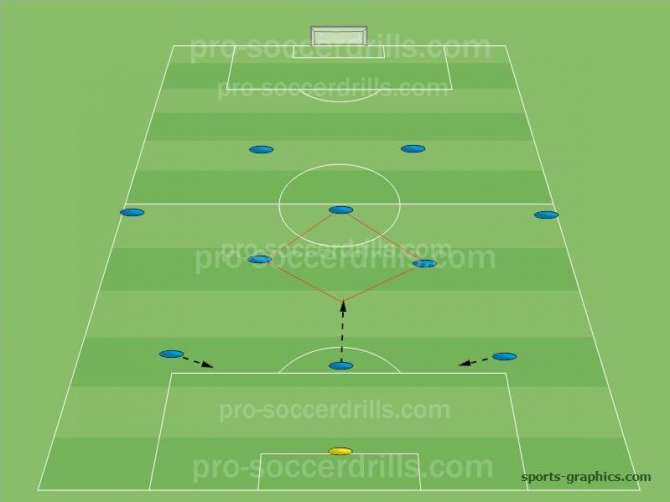
THE MIDFIELD FIVE
There are various opportunities to field the five midfielders in this formation. Also, there are plenty of instructions, opportunities and tactical variations to give to the players. Balance is the most important thing when choosing the right formation of the midfield five. The team should have width to be able to maintain possession and to be able to attack empty spaces on the flanks. There is always an overload in the centre zone, because the three players there could line up as 2-1 and 1-2 also depending on the style of play, the tactical variations and the opponent. It should be though a fluid midfield as there should be more space for them than in a formation with 1 striker.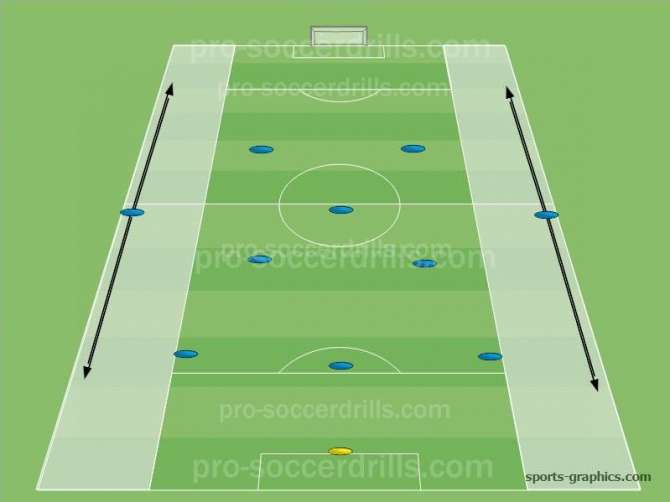
The distances between the players should be inconnection with each other. This centre midfield three should connect the wide players and the defenders with the strikers. Even in defence, these players should be able to defend the opposition’s central midfielders and the strikers that are stepping back in midfield. There is a great drill to improve the connection between the two strikers and the three centre midfielders: Defending Cooperation
As there is eight players playing in between the two flank spaces, there is a central overload, a numerical superiority. This requires game intelligence to play and exploit tight spaces.
The two wide players should give width to the team. Of course they can step inside, but the flank zones should always be filled by someone. It’s possible that in the opponent’s half, the wide players (call them wing backs or wide midfielders) can make their runs towards the goal but then another player should come out not to squeeze the opponent too much. If a team that has overload in the middle zones squeezes the opponent letting them defend tighter, getting behind them is more difficult. Width is key when in possession.
These two wide players should be quite fast and have the ability to make longer sprints many times. They should cross the ball well and also see the empty space in the front of them. As there will be many times when there is a 1v1 situation on the flank with a lots of space behind the defender, it’s key to be effective in these situations.
THE TWO STRIKERS
In the 3-5-2 there are two central strikers generally, but there are many opportunities for them, too. Coaches can play them as a 2 in line or as a 1-1 in the front of each other. With the last one the team will have a diamond in midfield and it adds one more line to the team. With two strikers in line there are more opportunities to exploit wing spaces from the centre that is harder to defend against. To be honest, strikers never or very rarely position themselves next to each other but they do it more diagonally. By stepping back or making a run forward diagonally, it is so much harder to defend these two players. It is possible that many coach bring back an additional player to the defensive line to have a free player that doesn’t mark any of these strikers. It’s all great for the team that plays a 3-5-2.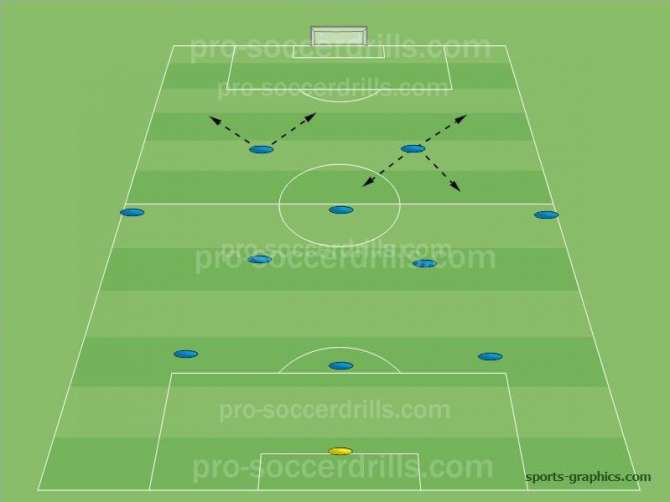
The strikers usually play facing their own goal but in this formation it is very flexible. Strikers can step back into empty spaces diagonally and wait for the ball in an open position and they can make a run towards the sideline as well. In both cases they don’t have to turn 180 degrees to the opponent’s goal but with a good quality first touch they can immediately create a chance. So this means strikers (or at least one of them) should be more mobile and good with the ball at his feet.
They should also understand their very important roles when they are pressing high, because with this formations it is easier to defend higher in the centre spaces also.
PRESSING IN THE 3-5-2
There are useful instructions for the players to give when teaching the pressing game in the 3-5-2 formation. As the opponent has the ball at the back, the two strikers should immediately put pressure on the man on the ball and the other one should cut one or two passing lanes. This requires game intelligence and understanding of the build-up play. By this, both players can threaten the opponent: one of them by pressing the ball carrier and the other by cutting his possibilities.
As there are 7 players in the front in this formation, it is expected to man-mark everyone in case of pressing.
The team should be compact but ready for the pressing when the goalkeeper has the ball. The two strikers “form” the play with their positioning. Most teams’ centre backs split and one player steps in (defensive midfielder most of the time), so strikers should mark one centre back (or threaten the passing lane by standing by) and the other should mark the player stepping back. By this, the goalkeeper has a very clear option to pass to.
As soon as this happens, the striker that marked the centre zone player should make his sprint and the other should threaten the back pass to the goalkeeper. Any other passes in the opponent’s defensive third would be very risky for them so we can expect a long-ball solution if it is well-timed.
Note that it is quite important for the striker that presses the CB to run from the passing lane between the CB and the defensive midfielder. By this, he picks out two players at once.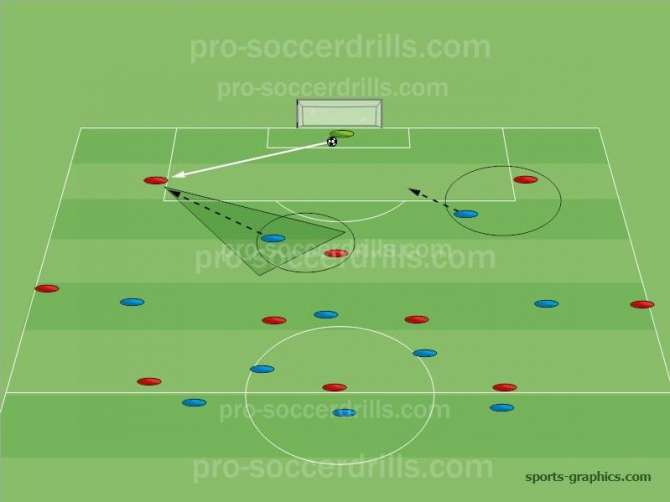
The whole midfield five should defend high to prevent the opponent from bringing the ball out from the back too easily. The centre backs have to be ready for the long balls maybe by using the offside line. The goalkeeper should also position himself high to be ready for the lofted balls.
COMPACT DEFENDING IN THE 3-5-2
When the team is pushed back, players can use the zonal defending tactics in the 3-5-2, too. They don’t have to switch into any other formation, but there are many similarities with others.
The back three often expands into a back five, so there are only three midfielders left. If our team is pushed back, the midfield three players are not enough to defend in the whole width. There are two possibilities for coaches to consider. Firstly, coaches can make one of their centre backs play as a defensive midfielder, or secondly, they can ask one of their strikers to join the midfield three. It depends on the opponent’s formation and the scoreline.
Zones can be separated during the training sessions and the functions can be taught step by step when the team has to defend as a unit. Here is a great analysis of this: Why Antonio Conte Changed Chelsea's Formation to 3-5-2?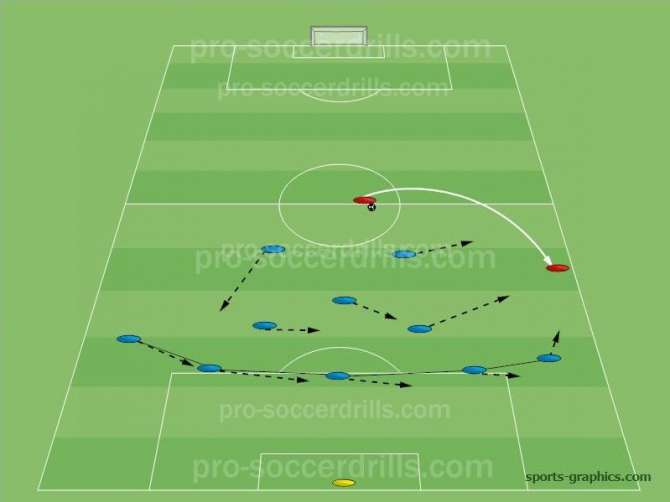
ADVANTAGES AND DISADVANTAGES OF THE 3-5-2
Advantages
- Great for pressing
- Changing roles when attacking
- Good for hard-working wingers
- Numerical superiority in the centre
- Good basic positions
Disadvantages
- Only three at the back
- Harder to defend the flanks
- Requires intelligent players in the centre
- Numerical superiority in the centre
- Good basic positions
SUMMARY
3-5-2 is not the most common system of play in the world, but it is very useful to teach. The roles, the positions are given and this means that the responsibility for each other is there between the players. It is a very flexible formation as you can have two stronger strikers or two smaller but with better technical skills.
In defense, most formations often transform into a 3-5-2 when needed, but without any intention. Just imagine doing it intentionally after the coaches taught the players as Massimiliano Allegri did it. You can read an article about this here: Football tactics explained: the most common formations – and how to beat them
It is an unending question whether it is a defensive or an offensive formation, but coaches can use it very well and effectively in both phases. One thing is sure, that players playing the 3-5-2 should have good technical skills to be able to possess the ball in the midfield. Because there is the overload numerically.
Free Trial
GET YOUR FREE 14 - DAYS TRIAL NOW! INCLUDING:




